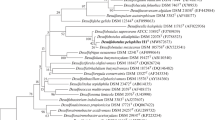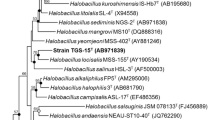Abstract
The isolation of a novel obligately chemolithotrophic, halophilic and extremely halotolerant Thiobacillus from a hypersaline lake is described. Attempts to demonstrate sulphur- and ferrous iron-oxidizing chemolithotrophs in neighbouring hypersaline lakes were unsuccessful. The organism isolated differs from any other Thiobacillus species previously described and is formally named as Thiobacillus halophilus. It possesses ribulose bisphosphate carboxylase and grows chemolithoautotrophically on thiosulphate, tetrathionate and sulphur, oxidising them to sulphate. Kinetic constants for oxidation of sulphide, thiosulphate, trithionate and tetrathionate are presented. The organism is obligately halophilic, growing best with 0.8–1.0 M NaCl, and tolerating up to 4 M NaCl. Optimum growth was obtained at about 30° C and pH 7.0–7.3. It contains ubiquinone Q-8 and its DNA contains 45 mol % G+C. Organisms of this type might contribute significantly to the autotrophic fixation of carbon dioxide in some hypersaline extreme environments of the kind described.
Similar content being viewed by others
References
Adair FW, Gunderson K (1968) Chemoautotrophic sulfur bacteria in the marine environment. Can J Microbiol 15:345–359
Beji A, Izard D, Gavini F, Leclerc H, Leseine-Delstanche M, Krembel J (1987) A rapid chemical procedure for isolation and purification of chromosomal DNA from gram-negative bacilli. Anal Biochem 162:18–23
Bounds HC, Colmer AR (1972) Comparison of the kinetics of thiosulfate oxidation by three iron-sulfur oxidizers. Can J Microbiol 18:735–740
Fredericq E, Oth A, Fontaine F (1961) The ultraviolet spectrum of deoxyribonucleic acids and their constituents. J Mol Biol 3:11–17
Kelly DP (1982) Biochemistry of the chemolithotrophic oxidation of inorganic sulphur. Philos Trans R Soc Lond [Biol] 298:499–528
Kelly DP (1990) Energetics of chemolithotrophs. In: Krulwich TA (ed) The bacteria, vol XII. Academic Press, New York, pp 479–503
Kelly DP, Harrison AP (1989) Genus Thiobacillus Beijerinck. In: Staley JT (ed) Bergey's manual of systematic bacteriology, vol 3. Williams and Wilkins, Baltimore, pp 1842–1858
Kelly DP, Chambers LA, Trudinger PA (1969) Cyanolysis and spectrophotometric estimation of trithionate in mixture with thiosulphate and tetrathionate. Anal Chem 41:898–901
Kolthoff IM, Belcher P (1957) Volumetric analysis, vol III. Interscience, New York, p 184
Oakley CL (1971) Antigen-antibody reactions in microbiology. In: Norris JR, Ribbons DW (eds) Methods in microbiology, vol 5 A. Academic Press, London, pp 173–218
Saslawsky AL (1927) Ueber eine obligate halophile Thionsaeure Bakterie. Zentralbl Bakteriol [Abt 2] 72:236–242
Saunders D, Hobbs R (1989) Corridors for conservation. New Scientist, January, pp 63–68
Smith DW, Finazzo SF (1981) Salinity requirements of a marine Thiobacillus intermedius. Arch Mikrobiol 129:199–203
Tilton RC (1968) The distribution and characterization of marine sulfur bacteria. Rev Int Oceanogr Med 9:237–253
Tuovinen OH, Kelly DP (1973) Studies on the growth of Thiobacillus ferrooxidans. Arch Microbiol 88:285–298
Tuttle JH, Jannasch HW (1972) Occurrence and types of Thiobacillus-like bacteria in the sea. Limnol Oceanogr 17:532–543
van de Graaff WJE, Crowe RWA, Bunting JA, Jackson MJ (1977) Relict early Cainozoic drainages in arid Western Australia. Z Geomorphol NF 21:379–400
Wood AP, Kelly DP (1983) Autotrophic mixotrophic and heterotrophic growth with denitrification by Thiobacillus A2 under anaerobic conditions. FEMS Microbiol Lett 16:363–370
Wood AP, Kelly DP (1985) Physiological characteristics of a new thermophilic, obligately chemolithotrophic Thiobacillus species, Thiobacillus tepidarius sp. nov. Int J Syst Bacteriol 35:91–94
Wood AP, Kelly DP (1986) Chemolithotrophic metabolism of the newly-isolated moderately thermophilic obligately autotrophic Thiobacillus tepidarius. Arch Microbiol 144:71–77
Wood AP, Kelly DP (1989) Isolation and physiological characterisation of Thiobacillus thyasiris sp. nov., a novel marine facultative autotroph and the putative symbiont of Thyasira flexuosa. Arch Microbiol 152:160–166
Author information
Authors and Affiliations
Rights and permissions
About this article
Cite this article
Wood, A.P., Kelly, D.P. Isolation and characterisation of Thiobacillus halophilus sp. nov., a sulphur-oxidising autotrophic eubacterium from a Western Australian hypersaline lake. Arch. Microbiol. 156, 277–280 (1991). https://doi.org/10.1007/BF00262998
Received:
Accepted:
Issue Date:
DOI: https://doi.org/10.1007/BF00262998




